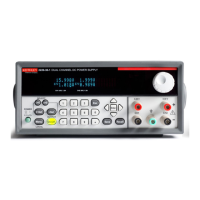Command Syntax
Table 2-2: Comm
and message elements
Symbol Meaning
<Header>
The basic command name. If the header ends with a question mark,
the command is a query. The header may begin with a colon (:)
character; i
f the command is concatenated with other commands the
beginning colon is required. The beginning colon can never be used
with command headers beginning with a star (*).
<Mnemonic>
A header subfunction. Some command headers have only one
mnemonic. I
f a command header has multiple mnemonics, they are
always separated from each other by a colon (:) character.
<Argument
>
A quantity
, quality, restriction, or limit associated with the header.
Not all commands have an argument, while other commands have
multiple arguments. Arguments are separated from the header by a
<Space>. A
rguments are separated from each other by a <Comma>.
<Comma> A single c
omma between arguments of multiple-argument commands.
It may optionally have white space characters before and after the
comma.
<Space>
A white space character between command header and argument. It
may optionally consist of multiple white space characters.
The following figure shows the five command mess age elements.
Figure 2-1: Command message elements
Commands
Commands cause the power supply to perform a specific function or change one
of its settings. Commands have the structure:
[:]<Header>[<Space><Argument>[<Comma><Argument>]...]
A command header is made up of one or more mnemonics arranged in a
hierarchical or tree structure. The first mnemonic is the base or root of the tree
and each subsequent mnemonic is a level or branch off of the previous one.
Commands at a higher level in the tree may affect those at a lower level. The
leading colon (:) always returns you to the base of the command tree.
Queries
Queries cause the power supply to return information about its status or settings.
Queries have the structure:
[:]<Header>
[:]<Header>[<Space><Argument>[<Comma><Argument>]...]
2-2 Series 2200 Programmable Multichannel D C Power Supplies Programmer Manual

